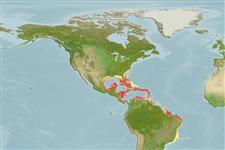Environment: milieu / climate zone / depth range / distribution range
Ecologia
marino associati a barriera corallina; distribuzione batimetrica 12 - 396 m (Ref. 9710), usually 18 - 90 m (Ref. 7251). Tropical; 32°N - 7°N, 99°W - 59°W
Western Atlantic: southern Florida (USA), Bahamas, Honduras and Virgin Islands; probably widespread in Caribbean reef areas. Including Antilles (Ref. 26938).
Size / Peso / Age
Maturity: Lm ? range ? - ? cm
Max length : 8.0 cm TL maschio/sesso non determinato; (Ref. 9710)
Spine dorsali (totale) : 10; Raggi dorsali molli (totale) : 12.
Found over rubble, silty or sandy bottoms (Ref. 9710). Often in small groups hovering over a patch of coral rubble or an old conch shell (Ref. 13442). Feeds on plankton (Ref. 9710). Synchronously hermaphroditic. Difficult to approach (Ref. 9710).
Life cycle and mating behavior
Maturità | Riproduzione | Deposizione | Uova | Fecundity | Larve
Pelagic spawner.
Robins, C.R. and G.C. Ray, 1986. A field guide to Atlantic coast fishes of North America. Houghton Mifflin Company, Boston, U.S.A. 354 p. (Ref. 7251)
IUCN Red List Status (Ref. 130435: Version 2024-2)
Threat to humans
Harmless
Human uses
Pesca: commerciale; Acquario: Commerciale
Strumenti
Special reports
Download XML
Fonti Internet
Estimates based on models
Preferred temperature (Ref.
123201): 23.3 - 28, mean 26.6 °C (based on 314 cells).
Phylogenetic diversity index (Ref.
82804): PD
50 = 0.5000 [Uniqueness, from 0.5 = low to 2.0 = high].
Bayesian length-weight: a=0.01096 (0.00518 - 0.02319), b=3.05 (2.88 - 3.22), in cm total length, based on LWR estimates for this Genus-body shape (Ref.
93245).
Trophic level (Ref.
69278): 3.1 ±0.2 se; based on diet studies.
Resilienza (Ref.
120179): Alto, tempo minimo di raddoppiamento della popolazione meno di 15 mesi (Preliminary K or Fecundity.).
Fishing Vulnerability (Ref.
59153): Low vulnerability (10 of 100).
Nutrients (Ref.
124155): Calcium = 125 [64, 270] mg/100g; Iron = 1.03 [0.55, 1.93] mg/100g; Protein = 17.7 [15.7, 19.4] %; Omega3 = 0.214 [0.115, 0.396] g/100g; Selenium = 42.5 [20.3, 93.8] μg/100g; VitaminA = 191 [61, 719] μg/100g; Zinc = 1.97 [1.25, 2.94] mg/100g (wet weight);
